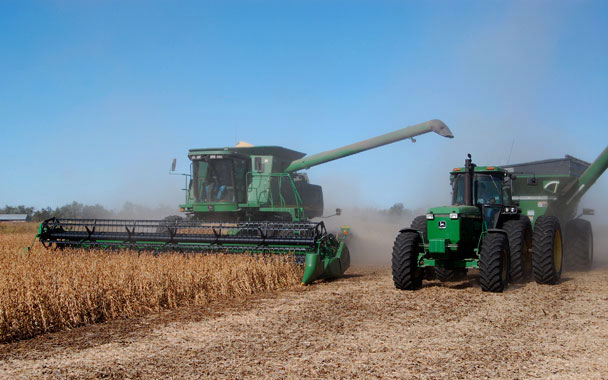A personal note: October is the most gorgeous month of the year on the northern Plains. The native grasses have cured to deep shades of red and yellow. Even the drab browns of August are translucent. The menacing clouds bearing July thunderstorms are long gone and the sky is so blue it blinds. Dogs, not quite tuned to the hunt yet, run through the color, sleek and fast, tongues flapping, noses to the wind...a sharptail grouse? No, only a meadowlark. The hunter’s adrenaline pulses nonetheless, his day-glow orange cap and vest bobbing across the undulations of the prairie. Geese are high in the sky. Their harmonies are heard before the V can be seen against the blue. In this landscape of subtle colors this is the season of riotous display.
For the next month, the spectacle will find its peak in the magic hour when the sun is low in the sky and the lights of a hundred lumbering tractors are refracted through the dust and spit of the soybean, sunflower and corn harvest. “Things are gonna get real speedy now,” Dale Hargens says. There is a thrill in his voice. This is a time when retired fathers are pressed into service, when long gone families come home to the farm for the weekend to lend a hand, and grandchildren are taught to drive a tractor. Every farm has its own choreography. “We’re about out of pasture.” Dale says. “We’ll be fixing fence in the early morning so we can turn the cattle out into the crop stubble. Then we’ll be combining until nine or ten at night.”
For ten days, the soybeans have been approaching maturity, but who among our four farmers will be first into the field? Scott Christenson will wait another week. He and his brother Roger were so focused on expanding their corn acreage last spring that they planted soybeans late. Too many plants in their fields are still green. All around him Charlie Johnson’s neighbors have fired up their tractors. But Charlie walked his fields on Wednesday, and decided to wait another few days. Farmers who are growing commodity beans can afford to harvest a small percentage of green beans together with their mature beans. The local elevator will take an uneven delivery. But Charlie’s beans are contracted to an organic soy milk processor, and the standards are very tight. Want that organic premium price? Better to wait a few more days. Jim Lutter is almost ready, but he has been busy with his buffalo roundup. That leaves Dale Hargens. He’s making payments on his combine, and there’s no reason to let it sit by the side of the house when it could be making money. On Wednesday, Dale began a custom harvest for his neighbor. But almost as soon as he started, green, wet, immature beans clogged the unloading auger in his combine and he had a breakdown. $1,000 for an overnight fix—the day’s profit—and he was back in the field Thursday morning.
Soybeans have been grown for oil and food in east Asia for 5,000 years. On the eve of the Revolution, American farmers began to experiment with the bean as a hay and oil crop, but soybeans have never had much romantic cachet. They are not linked to the foundation of civilizations like corn and wheat. It’s hard to imagine a bushel of soybeans sitting proudly next to pumpkins and apples at a roadside vegetable stand. Soybeans are the quintessential industrial crop for industrial agriculture. After all the jokes have been made about soy burgers and tofu, people turn their attention to vegetable oil, biodiesel fuel, cattle feed, soaps, resins, plastics, and then the bean’s versatility and value begins to show.
Soybeans moved slowly west onto the Plains. “When I was growing up, we didn’t think we had enough moisture to grow soybeans,” Dale explains. But when farmers shifted to moisture-conserving “no-till” planting techniques, and the genetics of the beans were altered to make them less sensitive to drought, soybean farming exploded. This year four million acres will be harvested in South Dakota alone, a stunning 27 percent increase over 2007.
Dale Hargens expects to combine 25,000 bushels this year. A month ago, when the price was high, he sold part of his crop for $12.50 a bushel. And he sold 10,000 bushels to a new processing plant being built by the local Hutterite colony a few miles east of the farm. The beans will be crushed for oil, and the byproduct sold to local turkey farmers as a high-protein feed. Dale plans to store 4,000 bushels of his harvest—and wait. Prices have dropped 25 percent in the last few weeks. Three dollars a bushel. Everyone is nervous about how the crisis on Wall Street will affect the commodity markets. Besides, there is always a downward pressure on prices as the harvest comes in, the glut factor, especially when the harvest is going to be big. Better to store the last 4,000 bushels at the local grain elevator, let the dust settle on Wall Street, and wait for prices to go back up.


